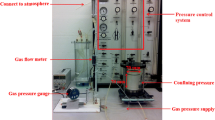Abstract
The thermal backfill is important for underground heavy crude oil storage tanks and oil pipelines to restrict the heat transfer through the source. The native soil might not be satisfactory as backfill material and, subsequently, require appropriate amendment. Biochar is a less thermally conductive material that can be amended to native soil to make it suitable for thermal backfill. A previous study found that adding different biochar fractions reduces the thermal characteristics of soil. However, in a previous study, soil-biochar composite (SBC) thermal characteristics were measured at maximum possible compaction states that are achieved at the maximum dry density and optimum water content. Consequently, the above results are the combination of the influence of maximum possible compaction states and biochar fractions. Therefore, to study the effect of different biochar fractions solitary on the thermal characteristics of SBC, the samples were compacted under two different conditions. In the first case, the sample was compacted at fixed load, while it was compacted at fixed density in the second case. The water content of SBC was kept the same for both cases. The soil was amended with three distinct biochar percentages (5, 10, and 15%) and three distinct biochar fractions [coarse (4.7–2 mm), medium (2–0.425 mm), and fine (0.425 mm-0.075 mm)], and their thermal characteristics were measured. The thermal characteristics of biochar admixed soil consistently reduced with a decrease in the size of biochar granules. Comparatively, the reverse trend was observed for the samples compacted at fixed density.
Access this chapter
Tax calculation will be finalised at checkout
Purchases are for personal use only
Similar content being viewed by others
References
Abu-Hamdeh NH, Reeder RC (2000) Soil thermal conductivity effects of density, moisture, salt concentration, and organic matter. Soil Sci Soc Am J 64(4):1285–1290
Abu-Hamdeh NH (2003) Thermal properties of soils as affected by density and water content. Biosys Eng 86(1):97–102
ASTM, D422–63 (2007). Standard Test Method for Particle-Size Analysis of Soils. ASTM International, West Conshohocken, PA. doi, https://doi.org/10.1520/D0422-63R07.
ASTM, D. 854 (2014) Standard test methods for specific gravity of soil solids by water pycnometer. West Conshohocken, PA; ASTM International, 2014.
ASTM, D4318–10. (2010). Standard test methods for liquid limit, plastic limit, and plasticity index of soils. West Conshohocken, PA; ASTM International, 2010.
ASTM D698–12 (2012) Standard test methods for laboratory compaction characteristics of soil using standard effort. Annual Book of ASTM Standards.
ASTM, D. 2487-11 (2011) Standard practice for classification of soils for engineering purposes (unified soil classification system) Annual Book of ASTM Standard. ASTM International, 4, 08
Burrell LD, Zehetner F, Rampazzo N, Wimmer B, Soja G (2016) Long-term effects of biochar on soil physical properties. Geoderma 282:96–102
Cuthbertson D, Berardi U, Briens C, Berruti F (2019) Biochar from residual biomass as a concrete filler for improved thermal and acoustic properties. Biomass Bioenerg 120:77–83
De Vries, D. A., 1966, Physics of Plant Environment, 2nd Ed., W. R. Van Wijk. Amsterdam: 487 North-Holland.
Głąb T, Palmowska J, Zaleski T, Gondek K (2016) Effect of biochar application on soil hydrological properties and physical quality of sandy soil. Geoderma 281:11–20
Gupta S, Kua HW (2017) Factors determining the potential of biochar as a carbon capturing and sequestering construction material: critical review. J Mater Civ Eng 29(9):04017086
Lehmann J, Joseph S (eds) (2015) Biochar for environmental management: science, technology and implementation. Routledge, New York, USA
Lu S, Ren T, Gong Y, Horton R (2007) An improved model for predicting soil thermal conductivity from water content at room temperature. Soil Sci Soc Am J 71(1):8–14
Patwa D, Chandra A, Ravi K, Sreedeep S (2021) Influence of Biochar Particle Size Fractions on Thermal and Mechanical Properties of Biochar-Amended Soil. J Mater Civ Eng 33(9):04021236
Patwa D, Muigai HH, Ravi K, Sreedeep S, Kalita P (2022) A novel application of biochar produced from invasive weeds and industrial waste in thermal backfill for crude oil industries. Waste Biomass Valorization 1–18. https://doi.org/10.1007/s12649-022-01694-0
Reddy KR, Yaghoubi P, Yukselen-Aksoy Y (2015) Effects of biochar amendment on geotechnical properties of landfill cover soil. Waste Manage Res 33(6):524–532
Liu Z, Xu J, Li X, Wang J (2018) Mechanisms of biochar effects on thermal properties of red soil in south China. Geoderma 323:41–51
Tong B, Kool D, Heitman JL, Sauer TJ, Gao Z, Horton R (2020) Thermal property values of a central Iowa soil as functions of soil water content and bulk density or of soil air content. Eur J Soil Sci 71(2):169–178
Usowicz B, Lipiec J, Usowicz JB, Marczewski W (2013) Effects of aggregate size on soil thermal conductivity: comparison of measured and model-predicted data. Int J Heat Mass Transf 57(2):536–541
**e X, Lu Y, Ren T, Horton R (2020) Thermal conductivity of mineral soils relates linearly to air—filled porosity. Soil Sci Soc Am J 84(1):53–56
Author information
Authors and Affiliations
Corresponding author
Editor information
Editors and Affiliations
Rights and permissions
Copyright information
© 2023 The Author(s), under exclusive license to Springer Nature Singapore Pte Ltd.
About this paper
Cite this paper
Patwa, D., Ravi, K., Sreedeep, S. (2023). Impact of Biochar Fraction on Thermal Characteristics of Soil-Biochar Composite. In: Muthukkumaran, K., Rathod, D., Sujatha, E.R., Muthukumar, M. (eds) Transportation and Environmental Geotechnics . IGC 2021. Lecture Notes in Civil Engineering, vol 298. Springer, Singapore. https://doi.org/10.1007/978-981-19-6774-0_29
Download citation
DOI: https://doi.org/10.1007/978-981-19-6774-0_29
Published:
Publisher Name: Springer, Singapore
Print ISBN: 978-981-19-6773-3
Online ISBN: 978-981-19-6774-0
eBook Packages: EngineeringEngineering (R0)




